-
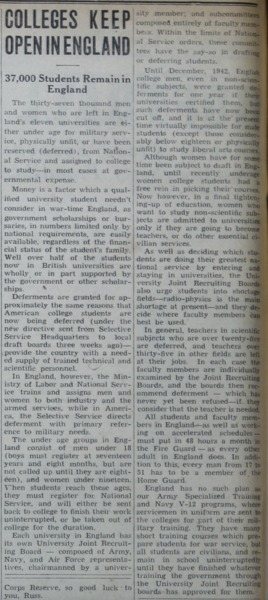
An article in the Loyola News discusses colleges staying open in England during World War II, including 37,000 students who kept studying at eleven universities. Most were not eligible for military service, including those under age and who were "physically unfit," as well as those "reserved (deferred) from National Service and assigned to college to study--in most cases at governmental expense." The article compares this to American students deferred to college study to ensure the country had enough "trained technical and scientific personnel." In England, after December 1942, these deferments (for male students) were nearly entirely for scientific students, and were not offered to liberal arts students. Female students wishing to study non-scientific topics could only do so if they planned to become teachers. Teachers and professors above a certain age were also mostly deferred and allowed to continue teaching. Yet all students and faculty still had to train for the Fire Guard, and all men between certain ages were automatically enrolled in the Home Guard.
-
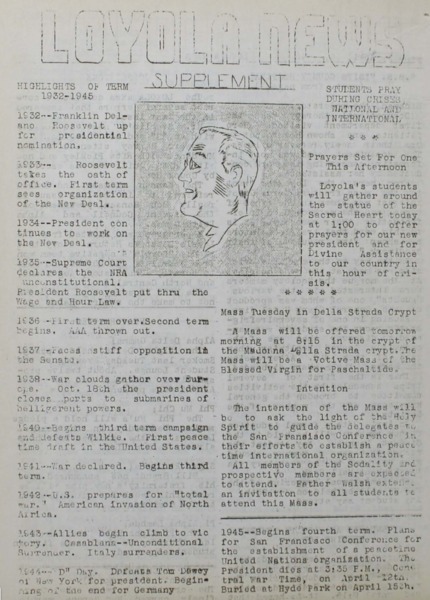
A page of the Loyola News Supplement displays a drawing of President Franklin Delano Roosevelt in profile in the center of the page. On the left column, the "highlights" of his 1932-1945 term in office are listed. The right column says "STUDENTS PRAY DURING CRISIS NATIONAL AND INTERNATIONAL," notifies readers that students will gather to pray at 1pm at the Sacred Heart shrine "to offer prayers for our new president and for Divine Assistance to our country in this hour of crisis." More masses would be held Tuesday at Madonna Della Strada, where the intention would be "to ask the light of the Holy Spirit to guide the delegates to the San Francisco Conference in their efforts to establish a peacetime international organization."
-
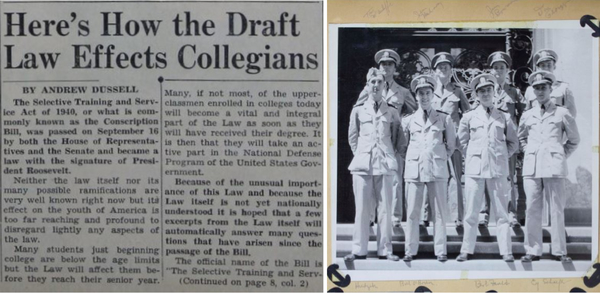
(left) “Here’s How the Draft Bill Effects Collegians,” Loyola News. Vol. 17, No. 2, pg. 1. October 2, 1940. An article published prior to U.S. entry into WWII discusses new developments in draft law and how they will affect Loyola students.
(right) Eight Loyola students in uniform stand in front of Mundelein College, photograph, University Archives and Special Collections, World War II Scrapbook
-
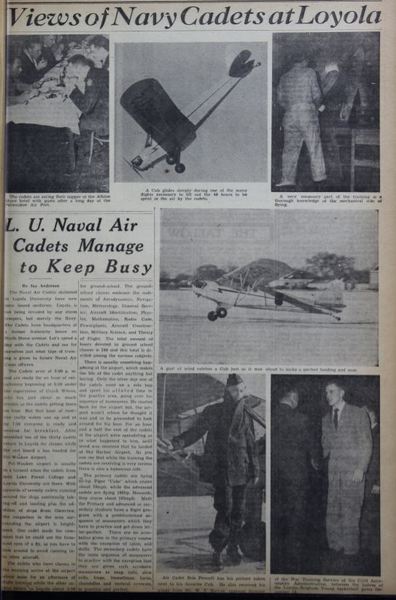
This article in the Loyola News contains six images captured during the Naval Air Cadets' training at Loyola. Pictured are the cadets eating their supper in uniform, a Cub glider in flight, cadets learning about the mechanics of flying, a glider on a landing strip, air cadet Bob Powell posing with their favorite glider, and a cadet shaking the hand of an officer.
-

(left) This Feb 7, 1940 article in the Loyola News describes the Civil Aviation Authority's (CAA) plans to offer advanced training at the thirteen selected universities where a primary flight training course was already in place. Loyola was one of these universities.
(right) An individual dressed in an Air Force uniform stands, smiling, to the side of a plane. The plane has the name "BAG-EARS" printed along the side of its nose. The words "ART DOUBLE" can be seen in the top right corner of the photo.
This collage was created using images from various sources (see 'Source' for more information).
-
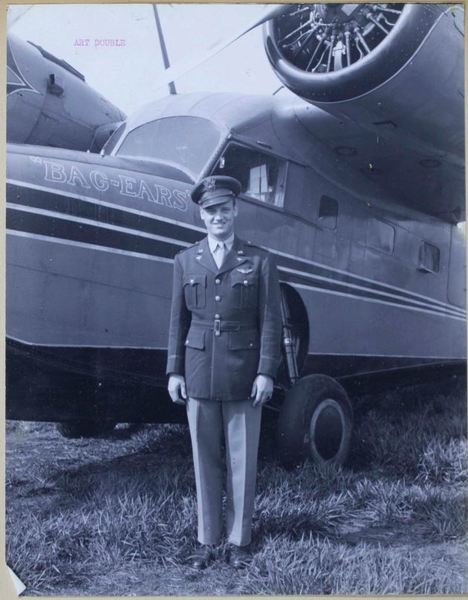
An individual dressed in an Air Force uniform stands, smiling, to the side of a plane. The plane has the name "BAG-EARS" printed along the side of its nose. The words "ART DOUBLE" can be seen in the top right corner of the photo.
-

This Feb 7, 1940 article in the Loyola News describes the Civil Aviation Authority's (CAA) plans to offer advanced training at the thirteen selected universities where a primary flight training course was already in place. Loyola was one of these universities.
-
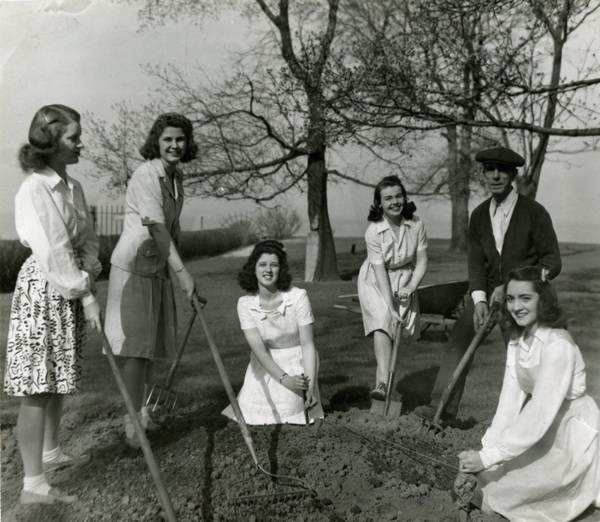
Ruth Wagener, Catherine Cunningham, Helen Watz, Mary-Jeanne Powers, and Dorothy help campus gardener William McViffie plant a war-time garden at Mundelein College.
-

Students graduating from the accelerated wartime program at Loyola head off to the military. Shown are Rev. Joseph M. Egan, James Fleming (Army), Robert Tietz (Army), William O'Brien (Navy), Jack Stanton (Army), Robert Nagler (Navy), and Cyril Schaefer (Navy).
-
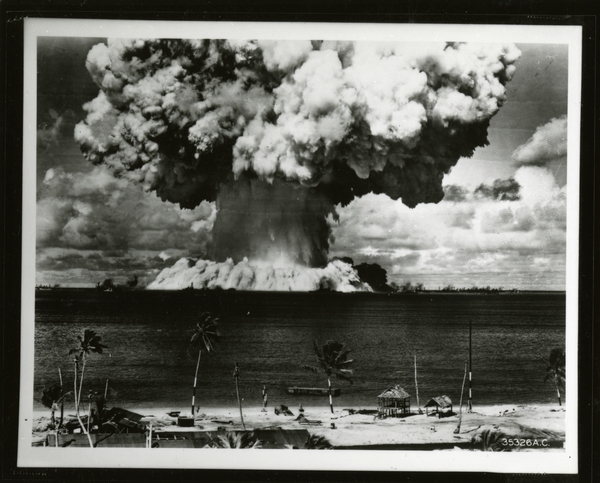
A photo captures the detonation of an atomic device in Operation Crossroads at Bikini Atoll in the Pacific Ocean. The mushroom cloud rises high above the ocean. A beach lies in the foreground with palm trees and small structures.
Creator(s): Department of Defense. Defense Atomic Support Agency. 5/6/1959-3/29/1971 (Most Recent)
-
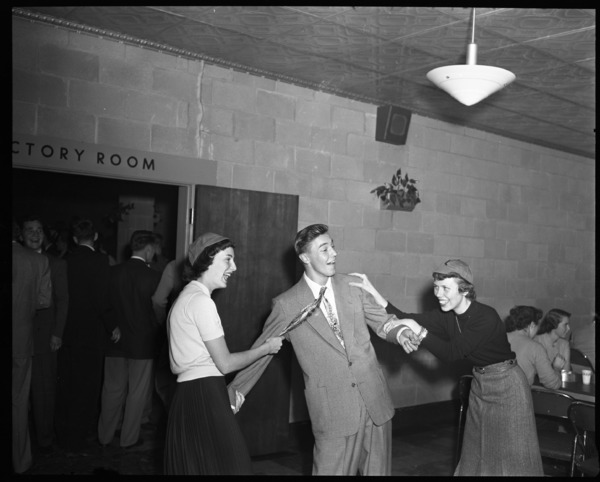
Two students wearing beanies jostle for the attention of another student at the Beanie Bounce. The student wearing a white blouse and skirt tugs at the tie of the center student whereas another student wearing a dark top and skirt pulls at the center student's shoulder.
-
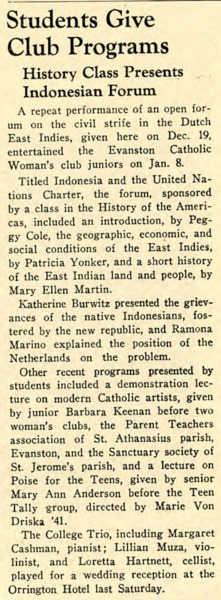
This Skyscraper article details the Indonesian forum, "Indonesia and the United Nations Charter", presented by students enrolled in a Mundelein history class. The forum focussed on the issue of the civil strife in Indonesia.
-

This Skyscraper article details the Indonesian forum, "Indonesia and the United Nations Charter", presented by students enrolled in a Mundelein history class. The forum focussed on the issue of the civil strife in Indonesia. [image cropped]
-
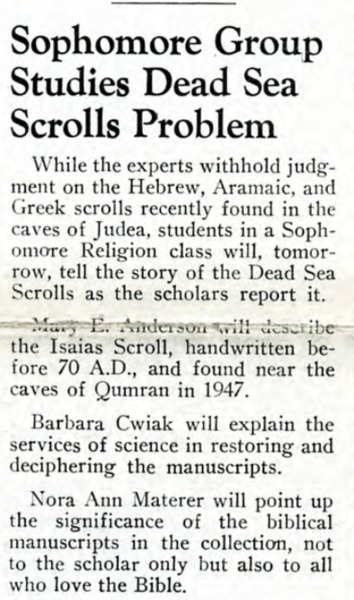
Mundelein College sophomores enrolled in a religion class discussed issues surrounding the Dead Sea Scrolls such as the scientific techniques used in deciphering them and their significance for "all who love the Bible." The Dead Sea Scrolls were found 10 years earlier in 1946.
-

Eleanor Roosevelt holds up a broadsheet of the Universal Declaration of Human Rights.
-
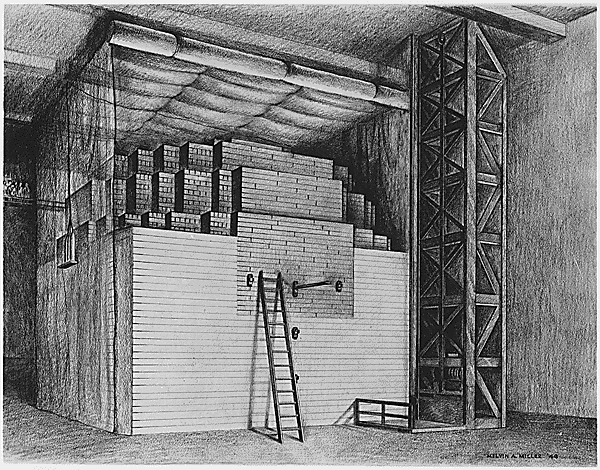
The first nuclear reactor was erected in 1942 in the West Stands section of Stagg Field at the University of Chicago. On December 2, 1942 a group of scientists achieved the first self-sustaining chain reaction and thereby initiated the controlled release of nuclear energy. The reactor consisted of uranium and uranium oxide lumps spaced in a cubic lattice imbedded in graphite. In 1943 it was dismantled and reassembled at the Palos Park unit of the Argonne National Laboratory where it is still functioning. The sketch is by Melvin A. Miller of the Argonne National Laboratory.
-
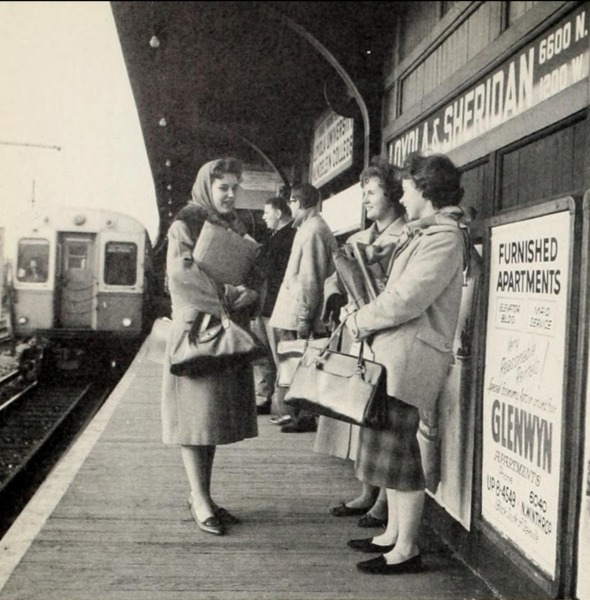
Several commuters stand around waiting for a train at the Loyola & Sheridan stop. To the left of the photo, an 'L' train can be seen pulling into the station.
-
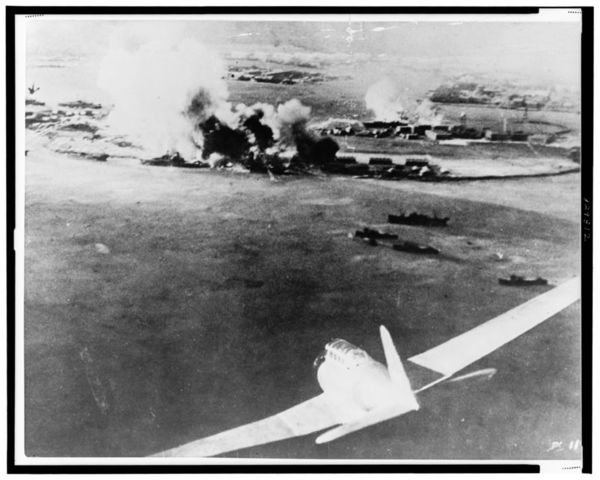
- 1 photographic print : gelatin silver.
- Title devised by Library staff.
- NEA Services photograph.
- Forms part of: New York World-Telegram and the Sun Newspaper Photograph Collection (Library of Congress).
- Published in: "War" chapter of the ebook Great Photographs from the Library of Congress, 2013.
-

A Mundelein student stands smiling in military uniform consisting of a skirt, hat and jacket with three buttons down the front. The pins on the lapels and hat feature an eagle. The caption beneath the picture states that she had gone on to enlist in the Navy after graduation.
-
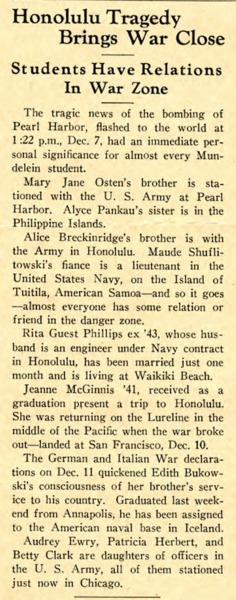
An editorial in the Skyscraper student newspaper lists the names of Mundelein students who were directly involved or who had relations stationed at Pearl Harbor when the bombing occurred.
-
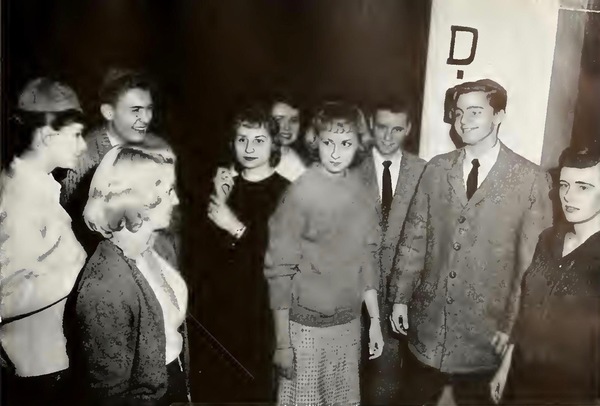
The Beanie Bounce was an annual event for Loyola freshmen and Mundelein students that began in 1949 and lasted until 1961. In the early years, Loyola students would hand their beanies to their partners at the end of the dance. In later years, the tradition changed and beanies were distributed before the dance. If Loyola students could find the Mundelein student holding onto their beanies, they could invite them to a dance.
-
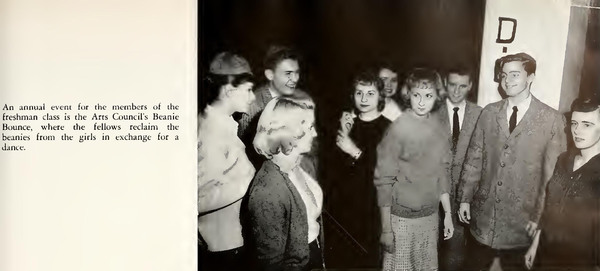
The Beanie Bounce was an annual event for Loyola freshmen and Mundelein students that began in 1949 and lasted until 1961. In the early years, Loyola students would hand their beanies to their partners at the end of the dance. In later years, the tradition changed and beanies were distributed before the dance. If Loyola students could find the Mundelein student holding onto their beanies, they could invite them to a dance.
-
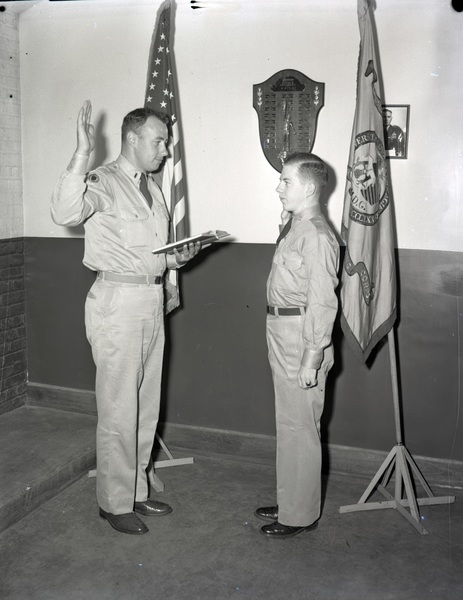
A college student takes an oath administered by an ROTC staff member.
A Reserve Officers' Training Corps (ROTC) unit was first established at Loyola on July 1, 1947 to train Infantry and Medical officers.
-
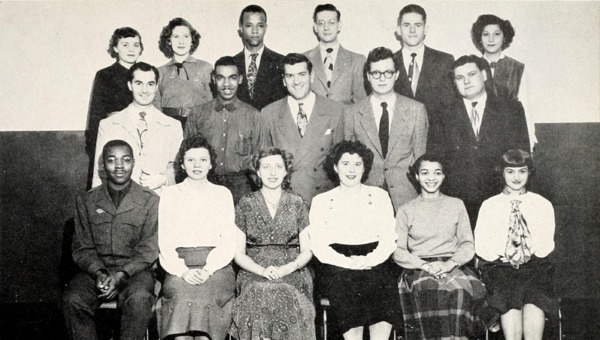
The Catholic Interracial Council was founded in 1947. Through the application of Christian principles, it sought to overcome racial barriers by educating students on race issues as well as organizing events that would foster interactions between students of different races.
-
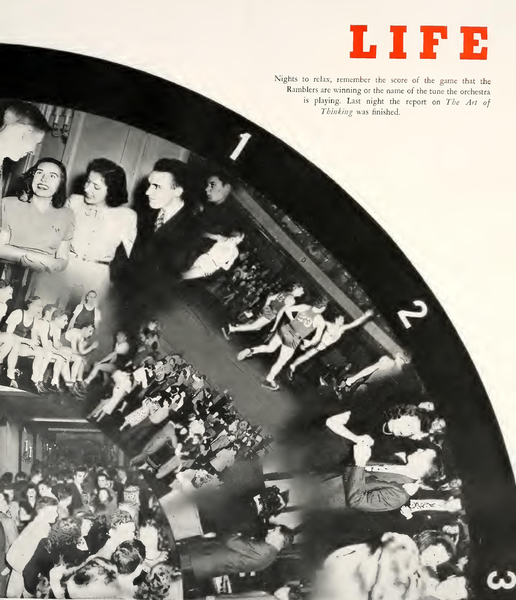
Students not only worked hard but also took the time to unwind and enjoy themselves by watching sports games and listening to live performances.

























